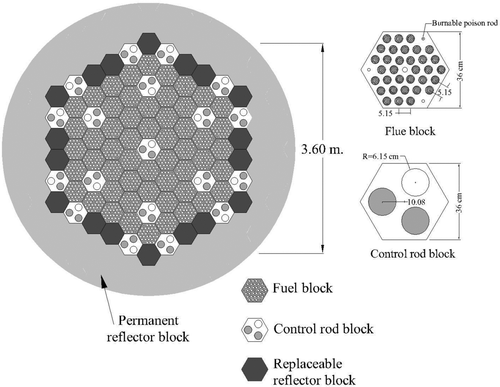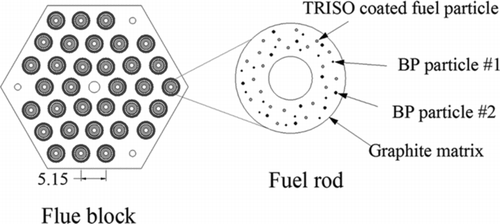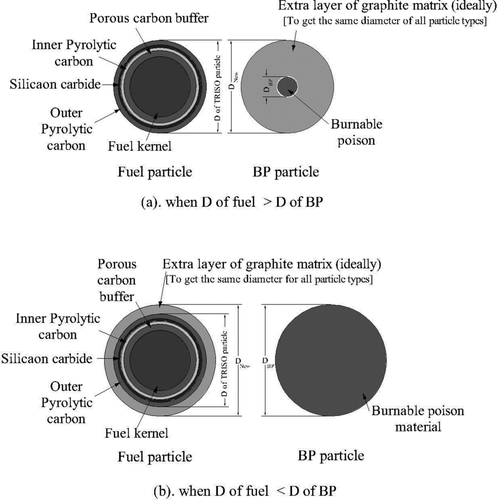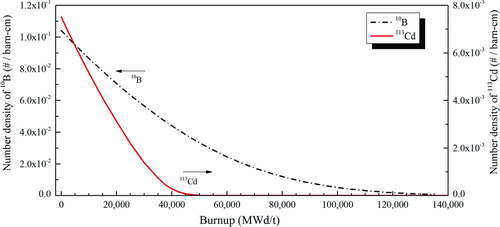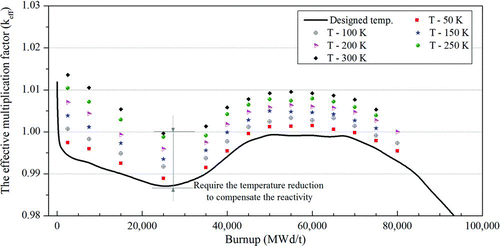Abstract
A design concept for a high temperature gas-cooled reactor without the possibility of a prompt supercritical accident has been proposed by coupling the use of particle-type burnable poison (BP) and criticality control by the core temperature. The combinations of two different BPs, B4C and Gd2O3 particles and B4C and CdO particles, with the proper particle sizes and the appropriate volume ratio, showed excellent performance in controlling excess reactivity and flattening the reactivity swing. To maintain reactivity at a lower level than the prompt critical state, the reactor was designed to operate in a subcritical mode for a burnup period or for the whole operation cycle. Under subcritical operation during the partial burnup period, the core temperature had to be lowered by at least 164 K for the loading of B4C + Gd2O3 particles and by at least 178 K for the B4C + CdO particles, which in turn dropped the thermal efficiency from 48% to 42.26% and 41.77%, respectively. On the other hand, under full subcritical operation, a greater decrease of core temperature was required. Remarkable decreases in the core temperatures, approximately 347 K for the B4C + Gd2O3 case and approximately 280 K for the B4C + CdO case, resulted in the drop of thermal efficiency to only 35.9% and 38.2%, respectively. Therefore, the relative importance of the increase in passive safety and the decrease in thermal efficiency must be considered with regard to their importance in nuclear reactor design.
1. Introduction
Inherent safety features are a vital part of nuclear reactor design. The high temperature gas-cooled reactor (HTGR) with low power density uses a graphite moderator as the large heat sink for passive decay heat removal during a loss-of-coolant accident and has no phase change of helium coolant, and thus, the HTGR is considered to have ‘passive’ safety design features. Theoretically, the reactor is best operated in the critical state in which the fission chain reaction can self-sustain on the balance of neutron production and neutron removal, when all control rods are withdrawn. But, in practical use, the large amount of fissile inventory is loaded into the core to obtain long-life reactor operation, and the reactor thus becomes supercritical with high excess positive reactivity insertion.
If the reactivity (ρ) can be controlled to remain below the prompt critical state at one dollar (1$) or equivalent to the effective delayed neutron fraction (β eff), the reactor can be controllable and operated safely. The β eff is strongly dependent on the composition of the fissile materials and the reactor type. Saito reported that the β eff of a high temperature engineering test reactor (HTTR), which used 235U as nuclear fuel, varied with the reactor operation between 0.47% Δk/k and 0.65% Δk/k [Citation1].
On the other hand, if the reactor operates with high positive reactivity, equal to or greater than 1$ (ρ ≥ 1$), it will be uncontrollable as there will be a dramatic increase in the neutron population and the reactor power will grow very quickly, contributing to a prompt supercritical situation. The Chernobyl accident is the worst-case scenario of a prompt supercritical accident due to a poorly designed reactor with large reactivity insertion. To prevent the reactor from experiencing a prompt critical or prompt supercritical situation, the minimum positive excess reactivity and the flattening of reactivity&break; during operation, are important to ensure a decrease of peak power density in the core, and they will contribute to a decrease in the maximum fuel temperature, which in turn depresses the risk of a fuel meltdown.
Several approaches have been used to control reactivity, such as mass control of the fissile material, controlling the reactor geometry, and using neutron absorber material. In HTGRs, the application of absorber material has been proven effective. Different geometries of burnable poison (BP), such as those involving cylindrical shape, microsphere shape, and homogeneous distribution, have been introduced and their performance at minimizing excess reactivity and flattening the reactivity-to-time ratio curve during the burnup period has been compared [Citation2–Citation4]. The implementation of different geometries of BP was first conducted by Van Dam [Citation2] in a pebble bed reactor instead of a prismatic reactor because of the similarity of the neutronic of these reactor types; therefore, the results obtained using the pebble bed reactor were also representative of prismatic reactors [Citation5]. Regarding the Van Dam study, it seemed that the cylinder shape was more powerful in the reactivity control; however, Kloosterman reported that better reactivity control was achieved with the use of spherical-shape BPs than with the cylindrical shape [Citation4]. However, to obtain excellent reactivity control using the cylindrical shape, it is necessary to produce BPs that are similar to small needles with radii of several tens of microns. Doing so is very difficult, and this difficulty constitutes one of the limitations of the cylinder shape [Citation2–Citation4].
In the present study therefore, we investigated the application of particle-type BPs. The application of BP particles has been accomplished in a pebble bed HTGR core once-through-then-out (OTTO) refueling scheme by adding the particles made of neutron absorber material into fresh fuel pebble balls. This approach showed that using BP particles can proficiently reduce the high power peaking factor in a pebble bed HTGR core by flattening the reactivity [Citation6]. The application of poison particles has also been introduced in a prismatic HTGR by Obara et al. [Citation7,Citation8], whose study showed that the utilization of BP particles instead of BP rods in a HTTR can control the reactivity within 1$ in the reactor core of a block-type gas-cooled reactor. On comparing between an original BP rod approach, in which the BP rods are inserted in the hole of the graphite block, which is used in the HTTR with 10 wt% enriched uranium on average, and the use of BP particles in the HTTR with more highly enriched uranium (20 wt%), it was found that the conventional BP rods can control the reactivity swing within only 2.6% Δk/k, whereas the use of BP particles with higher enrichment in the same reactor design, causing much higher excess reactivity, can effectively control the swing of reactivity within 1$ or approximately 0.67% Δk/k by withdrawing all of the control rods [Citation1,Citation7,Citation8].
Given this background, the purpose of the present study is to show a reactor concept that has no possibility of a prompt supercritical accident during an operation in a small, long-life HTGR using particle-type BP and criticality control by the core temperature. We also investigate the appropriate particle-type BP loading that will achieve the minimal excessive reactivity and the flattened reactivity swing, which are expected to reduce the possibility of any reactivity accident due to the use of particle-type BPs when all control rods are withdrawn.
2. Design concept to avoid prompt critical accidents
2.1. Reactor design concept
The 100-MWth prismatic HTGR that is the subject of this investigation is designed based on the HTTR [Citation9]. Spherical fuel kernels of 20% enriched uranium oxide (UO2) TRISO-coated particles are embedded in a graphite matrix with 30% packing fraction together with the proper diameter of BP particles (D) and the appropriate volume ratio of fuel kernels to BP particles (V F/V BP). shows detailed specifications of the reactor and the arrangement of 270 fuel blocks in total, stacked in five layers in the core region as illustrated in . Uniform temperature distribution is assumed throughout the core at 1200 K for all components, except for the coolant temperature which is slightly lower at 1000 K.
Table 1 Design specification of the 100-MWth prismatic HTGR
The Monte Carlo method by MVP and MVP-BURN codes [Citation10] is used to perform the neutronic analysis for the whole reactor core by coupling it with the JENDL-4.0 nuclear data library [Citation11]. To account for the separation of fuel particles and BP particles from the graphite matrix, the heterogeneity effect of multiple particles is taken into account by implementing the statistical geometry model (STGM) into the MVP and&break; MVP-BURN codes. shows a loading of three types of particles, including TRISO-coated fuel particles and two types of BP particles, in the graphite matrix of the fuel compact which is inserted in the graphite block. When multiple particles are introduced in the STGM model, the diameter of those particles must be treated the same as in the limited use of the STGM model. Hence, an extra layer of graphite, similar to the matrix material, is overlaid on the small fuel or BP particles to obtain the same diameter as that of the biggest particle. presents the cross sections of a fuel particle and a BP particle when they are treated with the same diameter in the STGM model. Figure is when the diameter of the BP particle is smaller than the TRISO fuel particle, and vice versa Figure .
2.2. Burnable poisons
Characteristics such as a large absorption cross sections and complete depletion without any residual absorption penalty remaining in the core are desirable for the neutron absorber material. We know that B4C, Gd2O3, and CdO are appropriate poison materials to minimize excess reactivity and control long-term reactivity by outreaching the prompt critical state during the burnup period. and illustrate the microscopic absorption cross sections of 10B, 155Gd, 157Gd, and 113Cd isotopes and their important properties, respectively. In this study, the isotopes of 155Gd and 157Gd in the compounds of Gd2O3 and 113Cd in CdO are the natural contents; only 10B in B4C is 90% enriched boron.
Table 2 The properties of burnable poisons [Citation6,Citation11]
Figure 4 Microscopic absorption cross section of main absorbing isotopes [Citation11]
![Figure 4 Microscopic absorption cross section of main absorbing isotopes [Citation11]](/cms/asset/d6503a43-fe35-4581-98b5-845ed66e36a8/tnst_a_815138_o_f0004g.jpg)
When spherical particles of BP materials are lumped into the graphite matrix, if the radius of a particle is smaller than the thermal neutron mean free path of the surrounding material (graphite) and larger in unit than its own thermal neutron mean free path, the particle can perform as a black absorber with the capability of absorbing all neutrons hitting its surface. A term of effective macroscopic cross sections, as given in Equation (Equation1), is introduced to explain the depletion behavior of BP black particles, which is a function of BP particle size and the number of BP particles [Citation2] in the following manner:
In this study, we examined the combined compositions of BP particles made from two materials, which have been reported in previous studies [Citation7,Citation8]. The combined use of B4C and Gd2O3 particles and the other combination of B4C and CdO particles can give satisfactory results in reactivity control by minimizing the excess reactivity until it is less than 1$, and by flattening the reactivity swing when applied in the HTTR [Citation7,Citation8]. Hence, the application of BP particles of two materials in the higher thermal power of the 100-MWth HTGR with larger sized core diameter is required to investigate this combination's capability in reactivity control.
2.3. Effect of particle-type burnable poisons on reactivity
It was reported in previous study that the combined use of B4C and Gd2O3 particles and that of B4C and CdO particles can successfully control the reactivity in the prismatic HTGR, and we therefore, used these BP particle parameters in the design of the 100-MWth prismatic HTGR in the present study as the starting values for the parametric survey [Citation7,Citation8]. The proper loading of BP particles is performed by making a parametric survey of the diameter of BP particles and the V F/V BP for the whole core analysis to minimize the excess reactivity and flatten the reactivity swing during the burnup&break; period. The parameter V F/V BP is used instead of the number of BP particles (N p).
Before examining our analytical results, we provide here the definitions of some important output parameters. The initial neutron multiplication factor (![]() ) is defined as the neutron multiplication factor after the important short-lived fission products become saturated. The calculation of the detailed burnup step during the beginning of reactor operation was performed to determine the saturation point of short-lived fission products such as 135Xe, 135I, 149Sm, and 149Pm from the change of number densities. The results showed that after the 4th burnup day or at the burnup of 250 MWd/t, the change of number densities of 135Xe and 135I became constant, corresponding to the change of the neutron multiplication factor. On the other hand, 149Sm and 149Pm, which have smaller thermal neutron absorption cross section, had less significant impact on the change of the multiplication factor. Hence the 4th burnup day or at burnup of 250 MWd/t is defined as the
) is defined as the neutron multiplication factor after the important short-lived fission products become saturated. The calculation of the detailed burnup step during the beginning of reactor operation was performed to determine the saturation point of short-lived fission products such as 135Xe, 135I, 149Sm, and 149Pm from the change of number densities. The results showed that after the 4th burnup day or at the burnup of 250 MWd/t, the change of number densities of 135Xe and 135I became constant, corresponding to the change of the neutron multiplication factor. On the other hand, 149Sm and 149Pm, which have smaller thermal neutron absorption cross section, had less significant impact on the change of the multiplication factor. Hence the 4th burnup day or at burnup of 250 MWd/t is defined as the ![]() for this study. Two other important output parameters are reactivity (ρ) and the reactivity swing (Δρ) as given in Equations (Equation2) and (Equation3), respectively. The reactivity swing is defined based on the difference between the maximum and minimum of reactivity during the burnup period, and is as follows:
for this study. Two other important output parameters are reactivity (ρ) and the reactivity swing (Δρ) as given in Equations (Equation2) and (Equation3), respectively. The reactivity swing is defined based on the difference between the maximum and minimum of reactivity during the burnup period, and is as follows:
In this section, the application of BP particles in the reactor target design is meant to keep the reactor operation under the critical state and control reactivity at lower than a prompt critical state during the operation without control rod insertion: 1 ≤ k eff < 1 + β eff. In this study, the target excess reactivity, which is determined as a criterion for safe reactor operation and for remaining free from a prompt critical accident, is defined as 0.50% Δk/k based on the β eff of the conventional HTGR, as described in Section 1. The combination of B4C with Gd2O3 particles and that of B4C with CdO particles results in varied particle sizes and the need to adjust V F/V BP to achieve the appropriate loading of those BP particles.
The parametric survey is performed by changing the diameter and the V F/V BP of the BP particles for each combination to determine the sensitivity of each parameter. shows the change of burnup characteristics by decreasing 10% of each parameter, the diameter and the V F/V BP, for the B4C + Gd2O3 case. Note that decreasing 10% of the diameter of the BP particles had a significant effect on the decrease of k eff, mainly at low burnup, due to fast depletion of the smaller-diameter BP particles, and then the effect vanished at higher burnup operation due to the burnout of the BP particles. However, deceasing 10% of the diameter of the BP particles can affect the increase of k eff at higher burnup due to the complete depletion of all BP materials, if a lower absorption cross section such as that of B4C, which is usually used for long-term reactivity control, has a small diameter. The decrease of V F/V BP whether in B4C, Gd2O3, or CdO results in a decrease of k eff for the whole burnup period due to the increased amount of the BP materials. To obtain the appropriate loading of BP particles, all criteria, including those of the critical reactor and excess reactivity not exceeding 0.50% Δk/k, must be met during the reactor operation.
Figure 5 The sensitivity of the parameters obtained using the combination of B4C + Gd2O3 particles loading
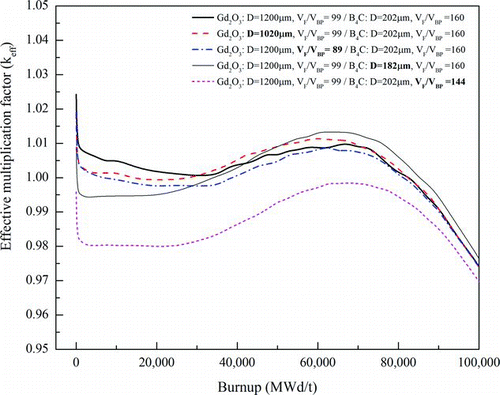
shows one of the appropriate combinations in an attempt of B4C particles with a diameter of 202 μm and V F/V BP of 160, coupled with Gd2O3 particles with a diameter of 1200 μm and V F/V BP of 99, which can better minimize the reactivity and flatten the reactivity swing than can one of the proper loadings of B4C + CdO particles. Comparing the reactor with and without BP particle insertion, we see that the initial excess reactivity, the maximum reactivity, and the change of reactivity-to-time decrease remarkably with the application of BP particles, as illustrated in . The maximum reactivity dramatically decreases from approximately 30% to less than 1% when the BP particles are added. However, adding poison materials to the core can cause a reduction of the discharge burnup from 102.8 GWd/t to 82.2 GWd/t and 80.7 GWd/t for the B4C + Gd2O3 case and the B4C + CdO case, respectively.
Table 3 Summary of the burnup characteristics of a reactor without BP particles and with the appropriate loading of BP particles
Figure 6 The effective multiplication factor (k eff) of the reactor without and with BP particles insertion at 1200 K
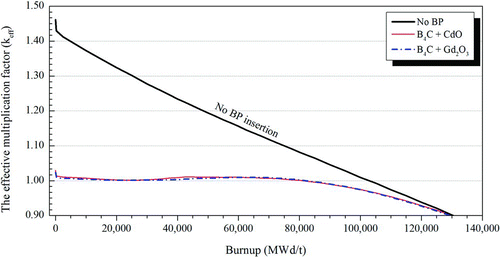
In Figure , we can see the concave shape of the k eff curve at the middle of the burnup period, caused by the self-shielding effect from the double heterogeneous forms of fuel particles and BP particles in a graphite&break; matrix. The decreased reactivity at the beginning of the cycle is mainly dominated by the self-shielding effect rather than the absorbing capability of the BP particles, and subsequently when the burnup increases, the effect from the self-shielding becomes less important and the decreased reactivity is governed mainly by the absorption of the BP particles.
Even the proper loading of BP particles can achieve lower reactivity and minimize the reactivity swing, but the maximum reactivity, 0.98% Δk/k for the loading of B4C + Gd2O3 or 1.32% Δk/k for the B4C + CdO case, is still greater than the target excess reactivity at 0.50% Δk/k, which can push the reactor into a prompt supercritical accident. We varied the diameter of the BP particles and V F/V BP in an attempt to obtain reactivity less than 0.50% Δk/k, but it was difficult to achieve the target design as reported by Obara et al. [Citation7,Citation8]. As a result of the different design geometry of the reactors, the 100-MWth HTGR has an equivalent core diameter of 2.8 m, which is almost equal to its effective core height of 2.9 m. In comparison, the HTTR has an equivalent core diameter of only 2.3 m, which is relatively smaller than its core height of 2.9 m. The different design geometries have different effects on the reactivity control.
However, calculations by the Monte Carlo method provide results with standard errors. As the result, it is difficult to ensure that the compositions shown in Ta- ble can give the best optimization conditions because the deviation of the results can also affect the variation of the parameters. shows the change in k eff when the diameter and the V F/V BP of B4C particles and those of Gd2O3 particles are decreased by 1% from the reference case. The decrease in the V F/V BP of B4C particles by only 1%, that is from 160 to 158, can have a significant impact on the change of k eff throughout the burnup period, but it is difficult to determine the change in k eff by the change of diameter and V F/V BP of Gd2O3 particles and the diameter of B4C particles, as shown in Figure . By using the MVP-BURN code, the calculations show an approximately 0.03% deviation in the k eff on total average. Therefore, the variation in BP parameters can be accepted as the appropriate condition if the differences in the results are within 0.06%, or twice the deviation in the k eff. The results of the important parameters, including ρ max, ρ min, and Δρ, and the difference compared to the reference case of B4C + Gd2O3 particles are summarized in . The results show that the change in the reactivity caused by the change in the diameter or the V F/V BP of Gd2O3 particles by approximately 1% is smaller than the two-sigma (2σ) of the statistical error in MVP and MVP-BURN calculations. The change in the reactivity caused by the change in the diameter or the V F/V BP of B4C particles by about 1% is larger than the 2σ. This means that the diameter or the V F/V BP of B4C particles has a greater effect on the reactivity compared to those of Gd2O3.
Table 4 The change in reactivity achieved by decreasing the parameters by 1% in the appropriate loading of B4C + Gd2O3 particles
Figure 7 The change in the k eff by decreasing the diameter and the V F/V BP by 1% for the appropriate loading of B4C + Gd2O3 particles

In the next section, we introduce the design for subcritical reactor operation during a partial burnup period in an attempt to achieve a safe reactor design without any prompt critical accident.
2.4. Loading of BP particles to avoid prompt critical accidents
In this section, we propose the design for a reactor that can operate whether under subcritical conditions with a small negative reactivity or under supercritical conditions with a positive reactivity lower than the target excess reactivity to avoid any anticipation of a prompt critical situation. This reactor concept is introduced to lessen the large positive reactivity that was described in the previous design section. To obtain the proper loading of the BP particles, the results from previous section are used as reference for the initial calculation in the survey calculation. The diameter and the V F/V BP are varied to obtain better conditions to achieve the requirements of reactivity lower than β eff and flat reactivity swing.
One of the appropriate loadings of the BP particles in an attempt is summarized in . The table shows that one of the appropriate loadings of the BP particles, for the combination case of 210 μm diameter B4C particles with V F/V BP of 155, coupled with 1200 μm diameter Gd2O3 particles with V F/V BP of 99, can effectively suppress the maximum reactivity to 0.52% Δk/k, which is a little higher than the target burnup at 0.50% Δk/k. For the case of 200 μm diameter B4C particles with V F/V BP of 140 and 1100 μm diameter CdO particles with V F/V BP of 293, the reactivity can be controlled to within 0.46% Δk/k, which is lower than the target excess reactivity at 0.50% Δk/k. However, the maximum reactivity obtained with the two combination cases is not significantly different when the statistical errors in the k eff calculation (approximately 0.03% in this study) from the Monte Carlo calculation are taken into account. Therefore, reactors with design operation, whether in subcritical or supercritical condition, implemented with BP particles, can safely operate and avoid prompt supercritical accidents.
Table 5 Summary of the burnup characteristics of a reactor without BP particles and with the appropriate loading of BP particles to avoid a prompt supercritical accident
Adding poison materials in the core can reduce the discharge burnup to 78.2 GWd/t when the B4C + Gd2O3 particles are loaded and to 75 GWd/t when B4C + CdO particles are loaded. The shortage of discharge burnup is caused by the residual absorption penalty due to incomplete depletion of the absorber materials, which can be explained by the change in the number density of the main isotopes. represents the change in the number densities of Pu isotopes with respect to the reactor operation for the case of B4C + Gd2O3 particles loading, which we used to discuss the temperature coefficient in the next section. The atomic number densities of 155Gd, 157Gd, and 10B, as shown in , are used to recognize the residual neutron absorber materials in the reactor core. We found that the number densities of 155Gd, 157Gd, and 10B dramatically decrease when the fuel burnup increases. The remarkable decrease in the reactivity during the low burnup is mainly caused by the larger absorption cross section of the 155Gd and 157Gd isotopes compared to that of 10B, resulting in the fast depletion of 155Gd and 157Gd. Isotopes of Gd burn out completely just before the end of the reactor operation whereas a small amount of 10B remains and burns out completely later on at a higher burnup step, resulting in a reactivity loss. illustrates the number densities of 113Cd and 10B with respect to the reactor operation for the proper loading of B4C + CdO. One can see that the depletion rate of 113Cd is faster than that of the 10B isotope and that the residual absorber material of B4C remains until the end of the cycle.
Figure 8 Change in the number densities of 239 Pu, 240Pu, 241Pu, and 242Pu isotopes in the fuel kernels for the appropriate loading of B4C + Gd2O3 particles
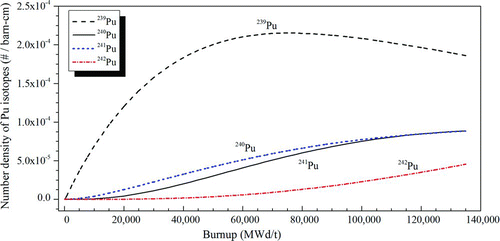
2.5. Criticality control by the core temperature
Although the reactor design with subcritical operation can behave as an intrinsically safe reactor, the subcritical reactor is only a theoretical nuclear fission reaction that cannot sustain a fission chain reaction by itself. A typical method such as the use of a neutron source must be applied to increase the neutron density in the subcritical reactor. In this study, the intrinsic characteristic of the HTGR, which is a negative temperature coefficient of reactivity, is employed to compensate for the absence of reactivity during the subcritical&break; operation. The temperature coefficient (αT) is defined as the change in reactivity per unit change in temperature. A uniform decrease in the temperature of all the components in the core, resulting in a decrease in the reactor power, leads to an increased positive reactivity due to the effect of the temperature coefficient. Consequently, the subcritical reactor becomes critical with the capability of self-sustaining a chain reaction.
To decrease the temperature of the reactor core, two prospective methods are available; increasing the flow of helium coolant or decreasing the reactor power, but these methods will not be covered in detail here. An increase in the coolant flow can be limited by the design geometry of the reactor core; therefore, the decrease of the reactor power is expected to be useful as an alternative approach to decrease the core temperature. The main objective of this study is to show the possibility to compensate for the reactivity by changing the core temperature. Further studies regarding the effective control of the core temperature are needed.
shows the k eff of the 100-MWth HTGR with the proper loading of B4C + CdO – 210 μm diameter B4C particles with V F/V BP of 155 and 1200 μm diameter Gd2O3 particles with V F/V BP of 99 – at the designed temperature of 1200 K and it shows the changes in the k eff when the core temperature is decreased by 50, 100 and 150 K. shows the burnup characteristics when the proper loading of B4C + CdO – 200 μm diameter B4C particles with V F/V BP of 140 and 1100 μm diameter CdO particles with V F/V BP of 293 – at the designed temperature of 1200 K, is performed, and it shows the changes in k eff when the temperature throughout the core is uniformly deceased by 50, 100 and 150 K from the reference.
Figure 11 The change in the k eff when the core temperature decreases from 1200 K for the appropriate loading of B4C + Gd2O3 particles
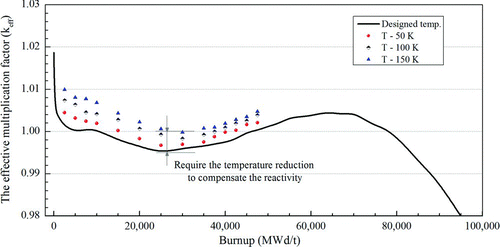
Figure 12 The change in the k eff when the core temperature decreases from 1200 K for the appropriate loading of B4C + CdO particles
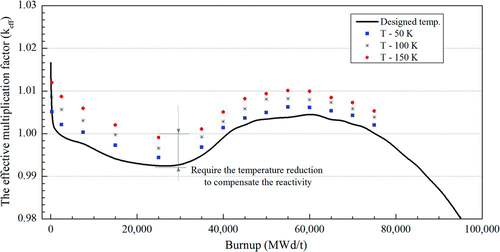
The negative reactivity during the subcritical state can be compensated by reducing the core temperature. The lowest negative reactivity for the appropriate loading of B4C + Gd2O3 particles in an attempt appears with the magnitude of –0.51% Δk/k at the burnup of 25 GWd/t. To make the subcritical reactor turn into a&break; critical reactor, the core temperature must be about 125 K lower than the designed temperature, that is, 1075 K. Unfortunately, the maximum requirement for the temperature reduction does not take place exactly at that burnup step, but instead appears later at the burnup of 30 GWd/t, at which point the reactivity is only –0.40% Δk/k. The core temperature must be reduced by about 164 K to compensate for the absence of the reactivity. The lower magnitude of negative reactivity observed during the period of highest temperature reduction can be explained by the change in the temperature coefficient during the burnup period, as shown in Figures and . The magnitude changes of k eff become smaller when the burnup increases, which is caused by the accumulation of 239Pu from the transmutation of 238U in the core with increased burnup, as shown in Figure . At high burnup, the temperature coefficient becomes less negative due to the important resonance absorption cross section of 239Pu buildup at low energy (∼0.3 eV), and an obvious sharp drop in the neutron spectrum is observed at that point, especially at high burnup. shows the change in the neutron spectra during the burnup period for the loading of B4C + Gd2O3 particles, when the core temperature is fixed at the designed value of 1200 K. A sharp decline in the neutron flux at different burnup levels is obvious at energy levels of ∼0.3 and ∼1.0 eV, resulting from the resonance cross sections of 239Pu and 240 Pu, by the transmutation of 238U. In addition, the resonance absorption cross section of Gd in the thermal region also has an impact on the less negative temperature coefficient, which can be compared with the magnitude of change in k eff between the cases using B4C + Gd2O3 and B4C + CdO, as illustrated in Figures and . Even the resonance absorption cross sections of 155Gd and 157Gd occur at ∼3.0 eV, but the largest absorption cross section of the Gd isotopes takes place at the lower energy of ∼0.2 eV which is higher than the resonance absorption cross section by about one order of magnitude. summarizes the negative reactivity worth with the insertion of the BP particles and the reactivity compensation attained by decreasing the core temperature.
Table 6 Compensation for the reactivity worth by decreasing the core temperature for reactors with the appropriate loading of BP particles to avoid a prompt supercritical accident
Figure 13 The neutron flux in fuel kernels at energy level 0.01–100 eV in various burnup periods: 10 GWd/t, 30 GWd/t, and 42.5 GWd/t
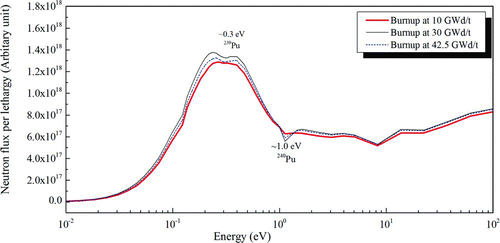
Although the decrease of core temperature can compensate for the missing reactivity, it directly impacts the decrease of the reactor power, which in turn decreases the efficiency of the thermal cycle.
2.6. Estimation of the change in thermal efficiency
In this study, the 100-MWth prismatic HTGR is assumed to have a power conversion system of the direct Brayton cycle, including intercooling and a high-efficiency recuperator, the same as in a gas turbine modular helium reactor (GT-MHR) [Citation12]. High temperature helium coolant from the reactor is expanded through the gas turbine to drive the generator and the compressor. Before returning to the reactor, low-pressure, low-temperature helium from the exhaust turbine is required to cool down by passing through the recuperator and the precooler, and it then increases the pressure by low- and high-pressure compressors with an intercooler, as shown in . By a direct Brayton cycle designed for the GT-MHR, when the reactor outlet helium temperature is assumed to be 850°C with a recuperator effectiveness of 0.95, the thermal efficiency of the GT-MHR can reach 48% [Citation12].
Figure 14 Diagram of the direct Brayton cycle [Citation12]
![Figure 14 Diagram of the direct Brayton cycle [Citation12]](/cms/asset/249b8a51-fba8-465d-abcb-ced5877b424d/tnst_a_815138_o_f0014g.gif)
Typically, there are many parameters affecting the thermal efficiency of the gas turbine Brayton cycle, but the most sensitive parameter affecting the efficiency is the reactor outlet coolant temperature, which is equivalent to the turbine inlet temperature. shows the change of plant efficiency as a function of the turbine inlet temperature [Citation13]. So far, regarding the effect of the turbine inlet temperature on the thermal efficiency of the GT-MHR, it has been reported that the increase or decrease of the outlet coolant temperature every 50 K, without changing the other parameters,&break; resulted in the change of thermal cycle efficiency by approximately 1.75% [Citation14].
Figure 15 The thermal efficiency of a gas turbine direct Brayton cycle in GT-MHR as a function of turbine inlet temperature [Citation13]
![Figure 15 The thermal efficiency of a gas turbine direct Brayton cycle in GT-MHR as a function of turbine inlet temperature [Citation13]](/cms/asset/4b9ba2d0-46be-4e45-bbe0-39a782260735/tnst_a_815138_o_f0015g.jpg)
For the proper loading of the BP particles described in the previous section, the core temperature must be reduced by at least 164 K for the case of B4C + Gd2O3 particles and by 178 K for the case of B4C + CdO particles, to compensate for the absence of the reactivity. Because the temperature coefficient is defined as a uniform temperature throughout the core, the coolant temperature must be decreased by the same magnitude as the reduction of the core temperature. Decreasing the core temperature by about 164 K for the loading of B4C + Gd2O3 particles results in the decline of thermal efficiency from 48% to 42.26% (a 5.74% drop). For the loading of B4C + CdO particles, the reduction of core temperature by about 178 K causes a decrease of thermal efficiency to 41.77% (a 6.23% drop), as presented in Table .
3. Design concept for avoiding supercritical accidents
In the previous section, we introduced the implementation of BP particles to control the reactor operation under either subcritical or supercritical condition without exceeding the prompt critical state at the target excess reactivity. In this section, the application of BP particles is introduced for a subcritical reactor for which the burnup period is controlled so that the reactivity is always zero or negative (k eff ≤ 1). The objective of this concept is to prevent the reactor from undergoing any supercritical operation accident.
3.1 Loading of BP particles
To obtain the appropriate BP particles loading, the parameters of the BP particles, i.e., the diameter and V F/V BP, are surveyed starting from the results described in the previous section. represents the appropriate loading of B4C + Gd2O3 particles and B4C + CdO particles in this attempt. For the case of B4C + Gd2O3 particles, the diameter of 215 μm for B4C particles and 1200 μm for Gd2O3 particles with V F/V BP of 148 and 96 for B4C and Gd2O3, respectively, are the appropriate composition to better control the reactor so that it has a negative reactivity throughout the burnup period. The use of particle-type BPs allows us to control the change in the reactivity to remain between –1.25% Δk/k and –0.094% Δk/k with the reactivity swing of 1.16% Δk/k, whereas the loading of B4C + CdO particles with the appropriate value can flatten the reactivity swing to 1.30% Δk/k. Even the loading of B4C + CdO particles can keep the reactivity closer to unity than can the B4C + Gd2O3 particles, but the use of B4C + CdO particles provides a larger swing of reactivity. The large change in the reactivity is caused by the higher burnup rate of 113Cd, which results in the complete depletion of 113Cd before the reactor reaches the target burnup. The faster depletion of 113Cd is due to a larger absorption cross section compared to the isotopes of 155Gd and 157Gd in the thermal neutron energy range of 0.1–1 eV, which happens at the peak of thermal neutron flux in the reactor.
Table 7 Summary of the burnup characteristics of a reactor without BP particles and with the appropriate loading of BP particles to avoid any supercritical accident during operation
Table 8 Compensation for the reactivity worth by decreasing the core temperature for subcritical reactors with the appropriate loading of BP particles to avoid any supercritical accident during operation
3.2. Reactivity compensation by decreasing the core temperature
As in the previous section, the effect of a negative temperature coefficient is applied to compensate for the absence of reactivity, to make the reactor reach unity. shows the effective multiplication factor with respect to the burnup period for the appropriate loading of B4C + Gd2O3 particles – B4C particles with a diameter of 215 μm with V F/V BP of 148 and Gd2O3 particles with a diameter of 1200 μm with V F/V BP of 96 – including the change of k eff when the core temperature is reduced from 1200 K to 900 K at a temperature interval of 50 K. The result shows that the temperature coefficient becomes less negative as the burnup period increases, because of the accumulation of 239Pu and the resonance absorption cross section of Gd in the thermal energy level. The maximum requirement for decreasing the core temperature is at least 347 K or a core temperature of 855 K, as shown in Table .
Figure 16 The change in the k eff when the core temperature decreases from 1200 K for the appropriate loading of B4C + Gd2O3 particles
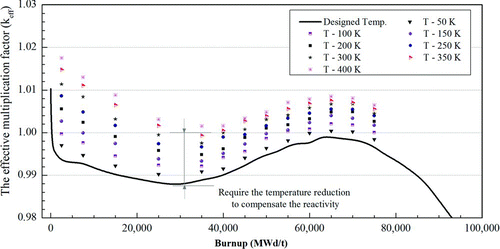
presents the neutronic analysis for the case of B4C + CdO in which the B4C particles have a diameter 205 μm with V F/V BP of 136 and the CdO particles have a diameter of 1100 μm with V F/V BP of 292. The figure shows that one of the appropriate loadings of B4C + CdO particles in an attempt results in a larger negative temperature coefficient and the decrease in the temperature coefficient, as the burnup period continues, is difficult to recognize compared to the application of B4C + Gd2O3 particles. As a result of the larger absorption cross section of 113Cd compared to that of the isotopes of Gd, the depletion rate of 113Cd becomes faster and the 113Cd completely burns out before the end of the reactor cycle. Therefore, the resonance absorption cross section of 113Cd, as a part of the thermal energy level, can have an effect on the less negative temperature coefficient only for a short burnup period. The maximum requirement for the decrease of the core temperature is about 280 K, which is lower than the proper case for B4C + Gd2O3 particles.
3.3. Thermal efficiency
Decreasing the operating core temperature to increase the reactivity can cause the thermal efficiency to decline. If the core temperature decreases by approximately 347 K in the case of B4C + Gd2O3, the thermal efficiency decreases from 48% to 35.9% (a 12.1% drop). For the reactor with B4C + CdO loading, even the minimum of worse reactivity is more negative than the case of B4C + Gd2O3 loading, but the temperature coefficient is larger, which in turn means that a lower decrease in the core temperature is required. Consequently, to operate such an inherently safe reactor loaded with B4C + CdO particles, the decrease of the core temperature by approximately 280 K is required to make the reactor critical, causing the thermal efficiency to be reduced to 38.2% (a 9.8% drop).
4. Conclusions
The implementation of the appropriate combination of two poison materials in the form of particle-type BP in the prismatic HTGR has been proposed to keep the excess reactivity lower than the prompt critical state at 1$. The matching of B4C particles and Gd2O3 particles and that of B4C particles and CdO particles was found to result in an excellent performance to suppress the reactivity and control the long-term reactivity. For the reactor design with typical operation (k eff ≥ 1), we found that the appropriate loading of BP particles in this attempt was unable to achieve a reactivity control lower than the prompt critical state or lower than the target excess reactivity of 0.50% Δk/k during the burnup period, because of the effect of neutron leakage by the reactor design geometry.
To suppose that outreaching the prompt critical state has been achieved, the designed reactor with a subcritical state for some operation periods can be attained. According to this concept, the reactivity control can be managed to be less than 1$ when the reactor is loaded with the appropriate BP particles. The lack of the reactivity during subcritical operation can be compensated by the effect of a negative temperature coefficient. Differences in the material and the composition of the BP particles loading have an effect on the temperature coefficient. To make the reactor operation turn critical, the core temperature must be decreased by about 164 K for the case of B4C + Gd2O3 particles and by 178 K for the case of B4C + CdO particles, which resulted in a drop of thermal efficiency from 48% to 42.26% and 41.77%, respectively.
To make the reactor safer, the reactor concept with subcritical operation for a whole operation period has been introduced, with which one can expect no prompt supercritical accident. Even the possibility of an accident from any supercritical operation can be eliminated, but a massive decrease in core temperature is desirable to compensate for the absence of reactivity, which in turn causes a remarkable drop in thermal efficiency. The worst case in the core temperature reduction occurred when the B4C + Gd2O3 particles were loaded, even when the k eff was worse than the case of B4C + CdO particles. This is because both cases had different temperature coefficients, caused by the different composition of the BP particles loading and the effect on the less negative temperature coefficient at high burnup. For the B4C + Gd2O3 particles loading, the core temperature had to be decreased by approximately 347 K, which can decrease the thermal efficiency by approximately 12.1%, whereas the loading of B4C + CdO particles required the core temperature to be lowered by about 280 K, with the resulting drop in the thermal efficiency of approximately 9.8%.
In summary, we found that the relative importance of both the increase in passive safety and the decrease in thermal efficiency must be considered with regard to their importance in nuclear reactor design. Our study results show that small, long-life HTGRs designed without the possibility of prompt critical accidents can be practicable with the use of particle-type BP, with some reduction of thermal efficiency. The successful use of BP particles to keep the reactivity lower than the prompt critical state during the withdrawal of all control rods makes this design concept more attractive than the typical design of BP rods, which cannot achieve reactivity control within 1$ when all control rods are removed. However, the use of particle-type BP is still in the conceptual stage, and the production of BP particles is prospected similar to the production of TRISO particles.
Notes
*At thermal neutron energy of 0.0253 eV
Note: BPP: burnable poison particle
**The reference case for the appropriate loading of B4C + Gd2O3 particles.
*α T,avg is the average of the temperature coefficients of reactivity, which vary during the burnup period and are identified at the burnup step in which the worst case of temperature reduction happens.
*α T,avg is the average of the temperature coefficients of reactivity, which vary during the burnup period and are identified at the burnup step in which the worst case of temperature reduction happens.
References
- Saito , S , Tanaka , T and Sudo , Y . 1991 . Present status of the high temperature engineering test reactor (HTTR) . Nucl Eng Des , 132 : 85 – 93 .
- Van Dam , H . 2000 . Long-term control of excess reactivity by burnable particles . Ann Nucl Eng , 27 : 733 – 743 .
- Talamo , A . 2006 . Effects of the burnable poison heterogeneity on the long term control of excess of reactivity . Ann Nucl Eng , 33 : 794 – 803 .
- Kloosterman , J L , Van Dam , H and Van Der Hagen , T HJJ . 2003 . Applying burnable poison particles to reduce the reactivity swing in high temperature reactors with batch-wise fuel loading . Nucl Eng Des , 203 : 105 – 115 .
- Knief , R A . 1992 . Nuclear engineering , Washington (DC) : Hemisphere Publications .
- Tran , H N and Kato , Y . 2009 . An optimal loading principle of burnable poison for an OTTO refueling scheme in pebble bed HTGR cores . Nucl Eng Des , 239 : 2357 – 2364 .
- Obara , T and Onoe , T . 2012 . Effect of particle type burnable poisons in HTGR . Tran Am Nucl Soc , 107 : 1023 – 1024 .
- Obara , T and Onoe , T . 2013 . Flattening of burnup reactivity in long-life prismatic HTGR by particle type burnable poisons . Ann Nucl Eng , 57 : 216 – 220 .
- Nojiri , N , Nakano , M , Ando , H , Fujimoto , N , Takeuchi , M , Fujisaki , S and Yamashita , K . 1998 . “ Preliminary analyses for HTTR's start-up physics tests by Monte Carlo code MVP ” . In JAERI-Tech 98-032 , Japan : Japan Atomic Energy Research Institute .
- Nagaya , Y , Okumura , K , Mori , T and Nakagawa , M . 2005 . “ MVP/GMVP II: general purpose Monte Carlo codes for neutron and photon transport calculations based on continuous energy and multigroup methods ” . In JAERI 1348 , Japan : Japan Atomic Energy Research Institute .
- Shibata , K , Iwamoto , O , Nakagawa , T , Iwamoto , N , Ichihara , A , Kunieda , S , Chiba , S , Furukawa , K , Otuka , N , Ohsawa , T , Murata , T , Matsunobu , H , Zukaran , A , Kameda , S and Katakura , J . 2011 Jan . JENDL-4.0: a new library for nuclear science and technology . J Nucl Sci Tech , 48 : 1 – 30 .
- LaBar , M P . 2002 . The gas turbine–modular helium reactor: a promising option for near term deployment . ANS 2002 Annual Meeting . June 9–13 2002 , Hollywood , FL . GA-A23952
- Juhasz , A J , Rarick , R A and Ranggarajan , R . 2009 . High efficiency nuclear power plants using liquid fluoride thorium reactor technology . AIAA Paper 2009-4565 presented at: 7th IECEC . Aug 2–5 2009 , Denver , CO .
- Golovko , V F , Dmitrieva , I V , Kodochigav , N G , Kuzavkov , N G , Chudin , A G and Shenoy , A . 2000 . “ Features of adapting gas turbine cycle and heat exchangers for HTGRs ” . In IAEA-TECDOC-1238, XA0103029 , Palo Alto , CA : Gas turbine power conversion systems for modular HTGRs .
